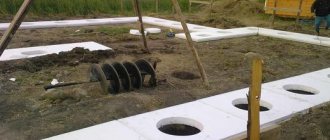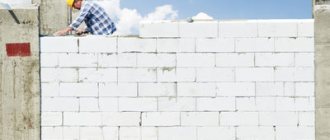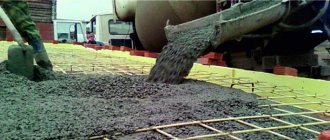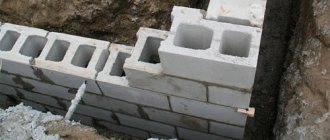Process Features
To raise a wooden structure, it is recommended to prepare the base for supporting the jack. The supporting platform must provide not only stability, but also freely accept the pressure from above. The raw material used is board or timber. The support is laid on the subgrade or foundation to ensure uniform distribution of the impact over it. If laying is done on the ground, it must first be compacted well.
Sliding is prevented by securely fixing the jack head when it comes into contact with the house. The main condition is the evenness of the log in the place to which the lifting force will subsequently be applied. It is allowed to use a metal plate measuring 10*10 cm with a slightly concave shape in the center. It is she who is subsequently placed between the jack and the wooden house.
How much does it cost to raise a house?
Approximate cost of raising a house on jacks: Lifting/leveling the corner of a house - from 9 thousand rubles. Lifting a small frame building/house - from 15 thousand rubles. Raising/leveling the wall of a large house - from 19 thousand rubles. Raising a house by 20 cm - from 20 thousand rubles. Raising a house by 30 cm - 40 cm - from 29 thousand rubles. Raising a house by 60 cm - 100 cm - from 49 thousand rubles. — 79 thousand rubles. Difficult lifting of a 2-story heavy house - from 99 thousand rubles. Lifting a heavy house by 1 m or more - from 150 thousand rubles.
When performing small one-day volumes of lifting and/or leveling work , the cost starts from 25 thousand rubles.
You can watch videos of our weekly meetings on Youtube
Contact us in any convenient way, describe your house (type of foundation, wall material, dimensions, height of the foundation from the ground, how much you would like to raise it). We will make an approximate calculation and answer how much it will cost to raise the house. Contacts We are ready to help you and share our experience! A visit from a specialist to an inspection costs us - from 500 rubles. , and after the inspection, you receive a technological solution, recommendations, an action plan and an accurate calculation of the cost of work and materials. You can watch a video of our specialist’s visit on Youtube
Example. Raising the house, laying the foundation under the house.
After raising the house, the foundation can be built up with concrete, blocks, and bricks. We recommend building up the foundation: - With concrete, if the foundation is weak, it crumbles, there are cracks on it. — Sand concrete blocks, if the foundation is good and the house is light. - Bricks, if the foundation is good and the house is heavy.
Example. Raising the house by 30 cm, building up the base with bricks
Example. Raising the house by 40 cm, building up the base with blocks
Example. Raising a house more than 1 meter, building up the base with blocks
You can watch more videos of our work on Youtube
What jacks are suitable?
To raise the house you will need jacks identical to those used in car workshops. Their main feature is the ability to lift a lot of weight. The load on the lift is preliminarily calculated taking into account the mass of the structure and climatic conditions:
- the total mass of the house is calculated as the sum of the masses of the external and internal walls, floors and roof. The total volume is estimated by multiplying the volume of wooden structures by the density of the material used during their construction;
- the additional weight of all communication lines and devices is added, the disconnection of which is impossible during the work;
- heavy elements of furniture and decor are not taken into account. They are first taken out of the house;
- the final load is multiplied by 20%. This ensures that the jacks can definitely lift the house. Allowance is made for moisture, which the wood actively absorbs.
Important! When jacks lift a wooden house, they should not operate at their maximum capacity (maximum load). For this purpose, a reserve of 20% is made.
In order to raise a panel house made of wood, you will need any of the existing types of lifting mechanisms. The main thing is to ensure that the load-carrying capacity of the tool matches the weight of the building. Do not allow the mechanism to operate at maximum values.
Screw
They are distinguished by the simplicity and reliability of the mechanism. They are made in the form of a screw, along the thread of which the contact pad moves. The latter is considered the fundamental load-bearing part of the mechanism. The product is characterized by high load capacity, compactness and ease of maintenance. Capable of lifting the weight of a building up to 50 tons.
Screw
Hydraulic
The mechanism of operation of the device is based on the lifting force of the liquid. It promotes displacement of the piston when pressure is created by a specialized pumping lever element.
There are several types of hydraulic devices:
- bottle (2-100 t). The main disadvantage: small initial working height. If you are considering replacing the location of a house in a country house, a model up to 10 tons will do. The remaining models are used preferably by professionals.
Bottle
- rolling Load capacity is not higher than 10 tons. The best option for a country cottage. The cost is slightly higher than the first option considered;
Roll-up
- with low lift. Expensive option. Expanded functionality: ability to work in horizontal and vertical planes. It is allowed to raise the house on a slope. Load capacity does not exceed 25 tons.
Both types of jacks are acceptable for raising a house. In terms of reliability, they are approximately equivalent. The choice depends on the price category of a particular model, its load capacity and build quality. It is not recommended to use Chinese products. Many manufacturers in this country are not scrupulous enough when it comes to compliance with specified technical and operational characteristics.
Major renovation
Lifting the house
First, let's look at how to raise a wooden house and pour the foundation if the old foundation has completely fallen into disrepair. For this operation you will need at least two jacks with a lifting capacity of 5 tons.
It is best to use hydraulic equipment. Of course, renting it is more expensive, however, the work in this case will be significantly simplified and speeded up.
Scheme for raising a house with a jack
So, the instructions for performing this operation are as follows:
- First of all, the corners are supported. You should start from the most sagging side. However, before installing the jack, it is necessary to concrete the areas on which it will be installed, or lay concrete slabs.
- Next, the house is lifted. This must be done slowly, carefully monitoring the distortion.
- After raising the wall by more than 1-2 cm, it is necessary to install supports, which can be used as wooden blocks. Supports should be placed on a hard, durable surface, just like jacks. The step between them should be about 30 cm.
If one of the jacks fails, the house will settle on the supports.
- According to the same scheme, the building rises along the entire perimeter until it reaches the required level.
Advice! Before lifting a wooden house, you can lay a beam on the jacks, which will allow you to evenly lift the wall and also prevent damage to the section of wood on which the jack will rest.
In the photo - making a strip foundation under a wooden house
Read also: The best washing vacuum cleaners reviews
Construction of the foundation
After raising the house, you can build a new foundation. Most often, this operation is performed in segments no more than 1.5 - 2 meters wide.
The work is performed in the following sequence:
- First of all, it is necessary to dismantle the corner of the old foundation.
- Next, you should prepare the soil - fill in a sand-crushed stone bed and fill in the footing (a bed of thin cement mortar).
- Then you need to make a reinforcing frame, which significantly increases the load-bearing capacity of the base.
- The next step is to install the formwork. The structure must be securely fastened.
- Next, you need to prepare a cement mortar from one part M400 cement, three parts sand and five parts gravel.
- The prepared solution should be poured into the formwork and compacted.
- After the concrete has completely hardened and gained brand strength, waterproofing should be laid on top of the foundation, and then the house can be carefully lowered.
Advice! Segments of the old foundation should be dismantled and replaced with new ones one at a time. In this case, the remaining areas will guarantee the safety of the work.
According to this scheme, a wooden house is raised onto the foundation along the entire perimeter. It should be noted that the base can also be made of brick or rubble stone, however, such a structure will be less durable.
Partial foundation repair
Partial renovation
Now let's look at how to raise the foundation of a wooden house with your own hands if it has sagged. This procedure involves “building up” the foundation and depends on the level of subsidence, as well as the material from which the foundation is made.
Often you can raise the foundation by laying timber or placing bricks under the house. You can also pour concrete under the logs after installing the formwork.
Advice! In the process of repairing the foundation, you can also replace the lower crowns of the house, both partially and completely. In a partial replacement, rotten areas are cut out and replaced with similar ones, which are joined “half a tree”.
Often home specialists are interested in how to raise a sagging corner of a wooden house if it is in poor condition and there is a possibility of its destruction? There are several options for solving this problem.
Replacement of the lower crown of the house
Most often, openings for jacks are cut out in the lower rims with a saw. In this case, it is necessary to use at least two jacks. As a result, the emphasis is on strong, non-rotten logs or beams.
If the lower rims do not change, logs of suitable size are installed in place of the cut openings. In this case, the joints are sealed with mineral wool, tow or other insulation.
There is also another way to raise the corner of a wooden house that has rotted. In this case, the frame is assembled and placed on jacks. Thanks to the frame, the structure is lifted evenly.
Lifting a wooden house using a frame
Advice! Many people in the process of home renovation are interested in how to raise the ceiling in a wooden house? The easiest way is to raise the walls and lay additional crowns.
Here, perhaps, are all the main points of lifting wooden houses to repair the foundation or lower crowns. It should be noted that many construction companies are engaged in such work, however, the price for the services of specialists is quite high.
Therefore, in many cases it is more advisable to do the work yourself. The main thing is to do repairs in a timely manner, which will significantly extend the life of the building.
How to raise a house with your own hands?
You can raise a wooden dwelling using a different number of lifting units:
- use of one lifting mechanism. Various points of the structure move in turn. The displacement in the vertical direction is strictly regulated - no more than 50 mm. Irreversible damage and deformation are prevented, as a result of distortion of door and window structures, the formation of cracks in the finishing façade material and damage to the integrity of the glass unit. The raised part of the house is fixed with wooden beams, and the lift moves further. Consistent work allows you to raise the structure to the same height;
- use of two lifts. The correct layout of the units is carried out to lift and move the house vertically. Both points do not need to be hung simultaneously. It is important to lift a certain section of the building one at a time, preventing the building from moving to the other side from the lifts and its severe deformation. The step-by-step instructions for performing the work are similar to the first method;
- The house can be raised using four lifting devices. Manipulations are characterized by synchronicity.
How to raise a brick foundation of a house
The construction of any house begins with the construction of its foundation - the foundation.
It follows that it must be erected with special care, in compliance with the norms and rules of masonry, because it determines how many years the future building will stand. Builders define the service life of the foundation and the entire structure as a period of time within fifty years. Time wears away stones, which means the foundation can settle or collapse. So questions arise for the owner of the house: “Why did the foundation begin to collapse? How to strengthen it?
As a rule, homeowners have little experience in repair and construction, so consultation with specialists, primarily geological engineers, is needed.
Preparatory operations
The installation option for the jack completely depends on the type of foundation structure. Tile and strip type bases require cutting niches in the shape of a rectangle. On a column-type and pile-type base, the mechanism is installed on wooden panels.
The location of the support should be smooth and even. Subsequently, a specialized metal tripod stand is installed on it. It is important to exclude the possibility of it slipping. The support allows you to adjust the structure in height.
Preparatory activities
Important! It is recommended to purchase special jack stands that are durable, stable and reliable.
Additionally, wooden plates with a width of at least 200 mm are purchased.
If a complete replacement of the foundation structure is planned, temporary support is required. It is created metal by welding corners and channels. This design is advisable until the new foundation reaches the required strength.
Lifting the house
Detailed instructions for performing house lifting operations:
- Work begins from the most sagging corner. Having retreated 1 m from the site, a hole is dug for mounting the platform and installing the jack. The soil must be dry and compacted.
- The lifting device is installed under the lower log. If it is intact and strong, a steel plate is mounted under the head. Otherwise, you need to cut a hole in the log for the jack pin, where the wood will be of better quality. Working with rotten and unreliable material is strictly prohibited. This is unsafe for the performer of the work.
- We are preparing to directly raise the angle. We resort to accuracy and attentiveness. It is not allowed to raise the house higher than 50 mm in one go. At the same time, the prepared supports and supports are wedged in. Provides relief from the weight on the jack.
Lifting
- The condition of the house is monitored. At that stage, complications may arise that are easier to eliminate at the moment.
- If you plan to lift the house with two jacks, prepare to work with the second corner. A recess for the pallet is dug in the same way. Subsequently, a device for lifting the house is installed on it. The device is brought under the log of the lower crown. A metal plate is placed on the head and the structure is raised. Wooden blocks and dies are inserted under the lower crown.
- The lift is installed in the middle of the log. Similar manipulations are performed. The house rises slightly by 20-30 mm. The thrust elements are lined.
- A return is made to the first corner. They lift it, trying to level the frame, but not higher than 60 mm. Supports made from blocks are used. They try to envelop the entire side with supporting elements.
- The wooden house is inspected again.
- Lifting units are removed from reinforced areas. They are being prepared for lifting from the other side. The work is done in the same way.
- A return is made to the first two corner sections. The structure is raised until the frame is fully leveled. Correctness is checked with a water building level.
- Raising is performed alternately in any direction until it is completely level.
- Reliable supports are installed under the walls. Along the perimeter of the entire house.
Instructions for raising a house
In practice, lifting a house is carried out quite rarely, but if it is already done, then all the work that is possible during this event is done. This includes the replacement of rotten lower logs, treatment with chemical compounds against fungus, and complete repair of the foundation. At the same time, the building frame is leveled.
Logs prepared to replace rotten ones must be dry, unaffected by bark beetles and treated with special solutions that protect against moisture. The bricks for the foundation are well-burnt and red in color. They are suitable for corners, can withstand loads of several tons and are not afraid of dampness. It is also necessary to prepare cement and sand for the solution.
All actions to lift the structure are done slowly and strictly following safety precautions . It is best to start such an event in the morning.
To raise a house with your own hands, the step-by-step instructions say the following:
- Start from the most sagging corner. At a distance of about a meter from it, they dig a hole in the ground to install a jack with flooring. The soil should be firm and dry.
- The lift is brought under the lower log, and if it is intact and strong, a prepared steel plate is placed under the head of the device. If the log is rotten, then cut a recess for the jack pin to a stronger surface.
- Proceed directly to raising the angle. They do it carefully. The lifting height should not exceed 5 - 6 cm at a time. At the same time, prepared supports and stands are wedged in to lighten the load on the lift.
- The structure is carefully inspected to identify unforeseen complications.
- If there are two jacks, the second corner is prepared for lifting. They also dig a hole for a pallet on which to place the next lift. They bring it under the log, place a plate on the head and lift the house. Place prepared bars and dies under the lower crown.
- Place the jack in the middle of the log. They do the same operations. Raise it a little, about 2 - 3 cm. Be sure to place stops.
- Return to the first corner. Raise it, trying to level the frame, but no more than 6 - 7 cm. Be sure to insert supports from chocks or blocks. They try to make sure that the entire side is supported.
- They inspect the building again.
- Jacks are removed from the reinforced and raised corners and the other side is prepared for lifting. Perform similar actions.
- Return to the first two corners and lift the house until the entire box is completely level. This is checked with a water level.
- The building must be raised clockwise or counterclockwise until the entire structure is level.
- Under the walls, reliable supports are placed under the lower crown along the entire perimeter of the building.
Read also: How is alternating current indicated on a multimeter?
After the house is raised, it is strengthened on all sides with props . Then the repair work necessary for this object is carried out.
Unlike a large house, a bathhouse can be raised faster. This takes 1 - 2 days. In some cases, it can be raised within a few hours. The speed of work depends on experience. If you have no experience in how to lift a bathhouse using jacks, a video that can be easily found on the Internet can help with this.
Raising a wooden house
Security measures
Whatever the reason for moving a house, the process is not safe. Especially if the work is supposed to be done manually. Before raising a structure, it is recommended to carefully study not only the technological process of the work, but also safe labor practices and precautions:
- During the preparatory process, the house is strengthened in all directions. The logs are fastened using boards; window and door structures can be protected from distortion using spacer beams;
- A specialized recess is prepared for installing the jack. It is exposed at the corner of the house;
- The lift is mounted only under a solid and wide surface. Experts advise pre-laying the boards;
- Initially, the condition of the lower crown logs is checked and their strength is monitored. Damaged areas are being strengthened. The technique used is to install metal beams;
- The possibility of damage to the logs can be minimized by placing a lining under the retractable rods of the plates. The place of support is made with a slight unevenness - a depression.
If you strictly follow the instructions and safe work practices, you can move the structure to the desired location efficiently and reliably.
Source
Preparing to install jacks
The method of installing the jack depends on the type of foundation of the house. On strip and slab foundations, you have to cut a rectangular hole either in the foundation or in the lower crowns. On columnar or pile foundations, strong wooden panels are laid on the ground, on which jacks are installed.
When equipping a place for a jack, it is necessary to prepare a flat and strong platform that will allow the tool to withstand the weight of the wall, which often reaches 3–5 tons. It is also necessary to stock up on metal triangular four-legged spacers (supports, bedside tables) with the ability to adjust in height (they can be purchased at any auto store), and wooden planks of various widths and thicknesses. It is advisable that the width of the slats should not be less than 20 cm, optimally 40–50 centimeters. Such planks can be made from boards with a thickness of 50, 25 and 10 mm, connecting them using half-wood jumpers of the same thickness.
If you are going to completely replace the foundation and grillage under the house, then you will need metal channels and corners to weld them into a temporary structure that will take the weight of the house until you finish all the work and the new foundation acquires the required strength.
Choose places for jacks so that the distance from the corner is 1–2 meters, and between the jacks there is 3–4 meters . Larger homes may require up to 10 jacks.
Do not forget that the jacks must be installed on the side of the lower beam of the casing (lower) crown. Therefore, first carefully inspect the house to determine the bottom beam or capping log. On the side of the upper beam, the requirements for installing jacks are lower - the distance from the corner is up to 4 meters and the distance between the jacks is up to 6 meters.
What structures can be lifted
For major repairs, only one-story buildings of the following types are raised: made of wooden beams;
from rounded and other logs; panel wooden houses. Structures made of timber or hardwood , such as larch and oak, last for quite a long time. There are still houses built before the revolution, which are over 100 years old and have retained their almost original appearance.
Modern wooden buildings are not so durable. The reason for this is the quality of the timber, which became especially susceptible to various diseases after the beginning of the “atomic era” and the ongoing testing of nuclear bombs.
In this regard, wooden structures must be thoroughly inspected to identify signs of rot and the appearance of fungus; the lower crowns of wooden houses are especially often affected by this.
How can you raise a log house?
Raising the frame with a jack is the only way to provide access to the foundation without dismantling the building itself. With due care, it is possible to raise the building with minimal damage, replace rickety or destroyed pillars, and also remove the lower logs, after which the frame is lowered into place.
The same work is carried out if the building begins to sink into the ground after the destruction of the foundation. In rural areas you can still find old log houses placed on wooden decks: such a foundation has a minimum service life and will still have to be replaced.
To carefully lift the structure, it is better to use several jacks with a load capacity of at least 5 tons. They can be hydraulic or mechanical, and a log jack screw is often used.
It is important to ensure that everything necessary for the work is delivered to the construction site in advance: the sooner the work is completed, the better. It is impossible to keep the log house raised for a long time; this can lead to very serious consequences.
How to lift a log house with jacks? Before starting the ascent itself, several preparatory steps should be completed:
- The basement cladding (if any) is dismantled; access to the foundation needs to be cleared along the entire perimeter. A trench is being dug, which will allow you to see the entire foundation of the house and assess any existing damage.
- The condition of the lower crowns is checked: they should be inspected; tapping with a hammer will determine the presence of sore spots. If there are signs of rot or deep cracks, the lower crown must be replaced.
In addition, it is important to determine the cause: logs rot due to improperly performed waterproofing, initially of poor quality, cracks may appear due to soil movements, etc. If the cause of destruction is not eliminated, repairs will have to be repeated very soon.
- It is advisable to prepare the house in advance to prevent possible damage: remove the window sashes so as not to damage the glass, temporarily remove the doors from their hinges, and sometimes dismantle the subfloor.
- Everything for work needs to be delivered to the site: jacks for raising log houses, material for the foundation, material for temporary supports, prepared logs for the new lower crown, etc.
It is also necessary to ensure that the jacks are installed on a durable base that can support the weight of the house and not sink into the ground. This can be a strong metal plate or at least a square wooden shield with a side of at least half a meter.
Log raising technology
Lifting a log house with a jack is not an easy, but completely doable task. It is important to take your time to avoid any serious damage.
If the building has a columnar foundation, it will not be difficult to place jacks under the lower crown, but if the building has a strip foundation, you will have to make recesses in the logs. In this case, you need to make a through hole in the log, into which you insert a lever and lift the wall with a jack.
The main stages of lifting a log house with your own hands:
- Work begins from the most damaged corner. Most often, the most serious damage is observed on the north side of the house. In a small structure, for example, in a small bathhouse, a log jack can only be installed at corners; in a permanent house, intermediate lifting and securing of the walls will be required, otherwise the logs will begin to sag.
- If you only have to use one jack to lift, the work will have to be done gradually. The wall is raised by a maximum of 2 cm, after which a support made of a concrete block, log or other durable material is placed under it, then the jack is moved to the next point, and the operation is repeated.
- Gradually the building rises along its entire perimeter. Usually, to carry out repair work, it is not necessary to lift it by more than 3-4 cm at a time. As a result, the building must be installed on strong temporary supports at the required height, after which you can proceed to restoring the foundation.
If a columnar base is used, the destroyed columns are broken and removed, after which they are replaced with new ones. If the house has a strip foundation, you will need to remove the remains of the destroyed foundation, deepen the trench and pour a layer of sand at the bottom.
Reinforcement is placed in the trench, formwork is installed, after which a new foundation for the house is poured. If the foundation has only minor damage, it is simply secured with an additional monolithic concrete belt.
Signs of Problems
There are several such signs and they can be seen almost with the naked eye.
Namely: partial or complete violation of the foundation of the house; deepening the foundation into the ground; subsidence of the building in one of the corners; large distortion of windows and doors, as well as the tilt of the building. After inspection and identification of many additional works, a decision is made to raise the house. At the same time they create a plan according to which they purchase the necessary building materials and tools. In addition, the following activities are planned for major repairs:
- replacement of rotten building crowns;
- preventing further subsidence;
- alignment of the distortion of the entire box around the perimeter;
- treating wood with chemicals to prevent rotting;
- complete or partial replacement of the foundation.
Such grandiose work is carried out within 1 - 2 weeks , involving the entire family and several invited specialists.
How to properly raise a brick house with a foundation
Sometimes it happens that you need to raise a brick house with a foundation. To a person far from construction issues, this seems impossible. In fact, it is quite possible to perform such an operation. The main thing is to choose the right tool and carry out the work, strictly observing their sequence.
Raising a brick house may be necessary to repair the foundation.
Preparing to lift the building
Before lifting the house, it is necessary to carry out actions to ensure ease of lifting and further repairs. This is done to protect against sudden and unexpected destruction of the structure. The following must be done:
- dismantle the outgoing sewer pipes;
- disconnect the power line;
- turn off the gas pipeline (if any);
- cut off the heating pipes from the boiler and disassemble the chimney;
- remove all furniture;
- remove all doors and windows from the boxes;
- reject or cut down interfering trees and bushes.
How to properly raise the foundation of a brick house with your own hands
Repair work related to the foundation is not only a labor-intensive process, but also requires certain knowledge and skills.
For those who are confident in their abilities and want to raise the foundation of their house on their own, this article with the necessary recommendations is dedicated. Once every few years - this is the frequency of repairs of brick houses carried out by companies (multi-storey and apartment buildings). As for your own private or country house, the question is “How to raise the foundation of a brick house?” concerns you individually, or at least employees.
Methods for raising the foundation
The choice of method to solve the main problem depends on the accompanying factors listed above. Only specialists can do this with their own hands. Otherwise, the situation may get out of control or become alarming.
- If there are depressions and cracks at the base. Requires cosmetic work if it is determined that these damages are not increasing.
- Work to strengthen the foundation. They require urgent stopping of the subsidence process. To determine the degree of subsidence, tape (beacons) is glued to the cracks, indicating the date of its installation. If the tapes break quickly, then you need to:
- dig small holes at an angle of no more than 35 ° C, into which metal or asbestos-cement pipes will be inserted (diameter about 20 cm);
- Next, cement mortar is poured directly under the foundation. This process can be stopped only after it stops decreasing on its own. Repeat about 3 more times.
- Perimeter destruction. At the beginning of the process, the cracked layer around the entire perimeter is removed. Next, the metal mesh is hammered into the base of the structure, and it is taken back a certain distance in order to attach it to the anchors protruding from the foundation and the base part. The next step is to install the formwork and concreting.
- In case of destruction of the strip foundation. The same steps are taken as in the previous version. It is possible to use curb stones, reinforced concrete blocks or screw piles.
- With increased load-bearing capacity. To do this, you need to unload the weak points by laying new parts along them in the form of metal or reinforced concrete beams. New sections will require through-hole anchoring.
- Restoration of columnar structures. A thorough process following the sequence of actions:
- transfer of the structure to temporary supports;
- pole dismantling work;
- creating a trench row under the house;
- compacting a sand cushion;
- installation of reinforced tape and its careful filling;
- installation of pillars in a strip;
- installation of steel beams (I-beams);
- returning the house to its original position with position adjustment for the full opening of windows and doors.
Such actions are suitable in the case where there is a fact of a broken foundation.
If the actions to raise the foundation and carry out repair work do not give the expected result, you should think about radically replacing its structure. The process is more labor-intensive and expensive, but guarantees a 100% positive effect.











